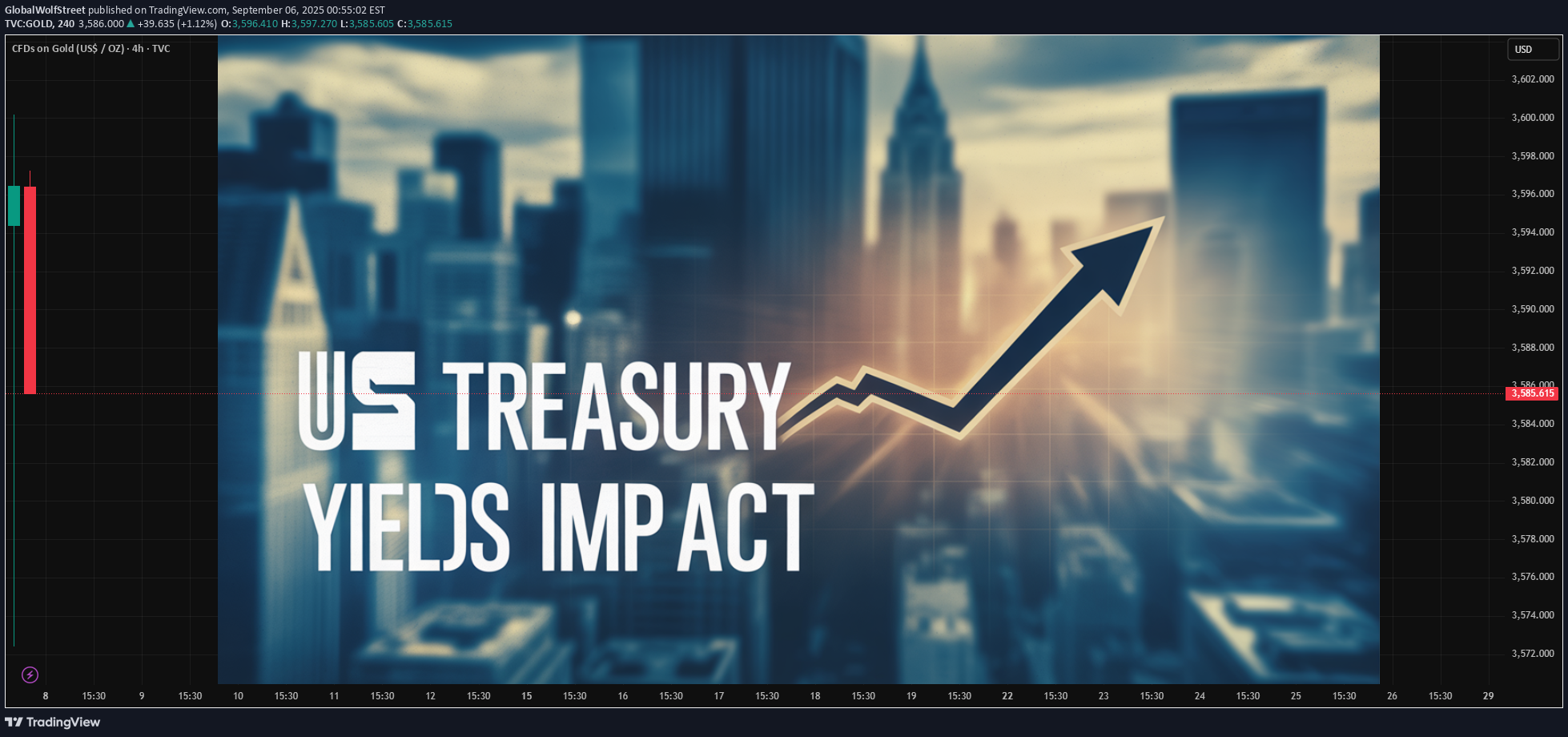06.09.2025 tarihinde sembol PAXG hakkında Teknik GlobalWolfStreet analizi

Part 1: Understanding US Treasury Yields 1.1 What Are US Treasury Yields? US Treasuries are debt securities issued by the US government to finance its operations. They come in different maturities—short-term bills (up to 1 year), medium-term notes (2–10 years), and long-term bonds (20–30 years). The yield on these securities represents the return an investor earns by holding them until maturity. Yields move inversely to bond prices. When investors sell Treasuries, prices fall and yields rise. Conversely, when demand is high, yields drop. 1.2 Why Are US Treasuries Called “Risk-Free”? The US government is considered the safest borrower in the world, backed by its ability to tax and print dollars. Thus, Treasuries are seen as risk-free assets in terms of default. This status makes them the benchmark against which global borrowing costs, equity valuations, and investment decisions are calibrated. 1.3 Drivers of Rising Treasury Yields US Treasury yields rise due to: Federal Reserve policy (interest rate hikes, balance sheet reductions). Inflation expectations (higher inflation erodes bond value, pushing yields up). Economic growth outlook (strong growth boosts demand for capital, raising yields). Government borrowing (higher fiscal deficits increase supply of Treasuries, pressuring yields higher). Part 2: Link Between Treasury Yields and Global Equities 2.1 The Discount Rate Effect Equity valuations are based on the present value of future cash flows. When Treasury yields rise, the discount rate (the rate used to calculate present value) increases. This reduces the attractiveness of equities, especially growth stocks with earnings expected far into the future. 2.2 Opportunity Cost of Capital Investors compare expected equity returns with risk-free Treasury yields. If yields rise significantly, the relative appeal of equities declines, causing fund flows to shift from stocks to bonds. 2.3 Cost of Borrowing for Corporates Higher yields mean higher borrowing costs globally. For companies dependent on debt, rising yields squeeze margins and reduce profitability, pressuring stock prices. 2.4 Risk Sentiment and Volatility Sharp increases in yields often spark volatility. Equity markets prefer stable interest rates. Sudden upward movements in yields are interpreted as signals of tightening liquidity or higher inflation risks, both of which unsettle investors. Part 3: Historical Case Studies 3.1 The 2013 “Taper Tantrum” In 2013, when the Federal Reserve hinted at tapering bond purchases, US Treasury yields surged. Emerging markets experienced massive capital outflows, and their stock markets plunged. This episode underscored the global sensitivity to US yields. 3.2 The 2018 Yield Spike In 2018, the 10-year US Treasury yield touched 3.25%, triggering global equity sell-offs. Investors worried about higher discount rates and slowing global liquidity. Technology and high-growth sectors were hit hardest. 3.3 The 2022 Bond Rout The Fed’s aggressive rate hikes in 2022 pushed the 10-year yield above 4%. Global equities, including the S&P 500, Europe’s Stoxx 600, and Asian indices, fell into bear markets. The pain was widespread—ranging from US tech giants to emerging-market stocks. Part 4: Sector-Wise Impact of Rising Yields 4.1 Growth vs. Value Stocks Growth stocks (e.g., technology, biotech) are most sensitive. Their long-duration cash flows are heavily discounted when yields rise. Value stocks (e.g., banks, industrials, energy) often fare better. Banks, in particular, benefit from higher interest rates via improved net interest margins. 4.2 Banking & Financials Higher yields typically boost profitability for banks and insurers, as they can lend at higher rates. Global financial stocks often outperform during rising-yield phases. 4.3 Real Estate & Utilities These sectors are bond proxies—investors buy them for stable dividends. When Treasury yields rise, their relative appeal diminishes, leading to underperformance. 4.4 Commodities & Energy Commodities often benefit indirectly if yields rise due to stronger growth expectations. However, if yields rise because of inflation and monetary tightening, commodities may face demand destruction risks. Part 5: Geographic Sensitivities 5.1 United States US equities are most directly impacted. The Nasdaq (tech-heavy) suffers more than the Dow Jones (value-oriented). 5.2 Europe European equities track US yields closely. Higher yields in the US can lead to stronger dollar, pressuring European exporters. Additionally, Europe’s bond yields often rise in sympathy, tightening financial conditions. 5.3 Emerging Markets Emerging markets are the most vulnerable. Rising US yields trigger: Capital outflows (investors shift to safer US assets). Currency depreciation (raising import costs and inflation). Stock market sell-offs (especially in countries reliant on foreign capital). For example, India, Brazil, and Turkey often see sharp corrections when US yields spike. 5.4 Asia (Japan, China) Japan: Rising US yields weaken the yen (as investors chase dollar returns), which can help Japanese exporters but hurt domestic equities tied to imports. China: Sensitive due to capital flows and trade dynamics. Rising US yields often pressure Chinese equities, especially during growth slowdowns. Part 6: Currency & Global Equity Interplay Rising US yields usually strengthen the US dollar. A stronger dollar reduces profits of US multinationals, pressures commodity prices, and creates headwinds for emerging-market equities. For global investors, currency-adjusted returns from foreign equities decline when the dollar is strong, further reducing equity allocations abroad. Part 7: Broader Macroeconomic Implications 7.1 Liquidity Tightening Higher yields reduce global liquidity. Central banks in other countries often follow the Fed to prevent capital flight, tightening financial conditions worldwide. 7.2 Inflation & Growth Trade-Off Rising yields often reflect inflationary pressures. Central banks respond with rate hikes, slowing global growth. Equity markets suffer as both margins and valuations come under pressure. 7.3 Safe-Haven Flows Paradoxically, in times of global turmoil, US Treasuries attract safe-haven flows, lowering yields again. But during inflationary cycles, this dynamic weakens, making equities more vulnerable. Part 8: Coping Strategies for Investors 8.1 Diversification Investors hedge against rising yields by diversifying into value stocks, commodities, and sectors benefiting from higher rates (like banks). 8.2 Global Allocation Allocating across geographies can help. For instance, some Asian and European stocks may perform better depending on currency moves and domestic cycles. 8.3 Use of Derivatives Investors use interest-rate futures, options, and currency hedges to manage risks from rising yields. 8.4 Tactical Shifts Moving from growth to value, reducing exposure to high-duration equities, and increasing allocation to inflation-hedged assets are common strategies. Part 9: Future Outlook The long-term trajectory of US Treasury yields depends on: US fiscal deficits and borrowing needs. Federal Reserve policy normalization. Global inflation cycles. Geopolitical shifts in demand for US Treasuries (e.g., de-dollarization trends). For global equities, this means heightened sensitivity to yield cycles. Investors must closely monitor not only the direction but also the pace of yield movements. Gradual increases may be absorbed, but sharp spikes usually destabilize global equities. Conclusion The relationship between US Treasury yields and global equities is one of the most powerful forces in financial markets. Rising yields act as a tightening mechanism, reducing equity valuations, increasing corporate borrowing costs, triggering capital outflows from emerging markets, and strengthening the US dollar. The effects vary across sectors and geographies—hurting growth stocks, real estate, and emerging markets, while benefiting banks and certain value-oriented sectors. History shows that equity markets can tolerate moderate, steady increases in yields, particularly when driven by strong growth. However, rapid spikes often cause global turbulence. For investors, understanding these dynamics and positioning portfolios accordingly is crucial. In essence, rising US Treasury yields are not just an American story—they are a global story, shaping equity performance from Wall Street to Mumbai, from Frankfurt to Tokyo.
